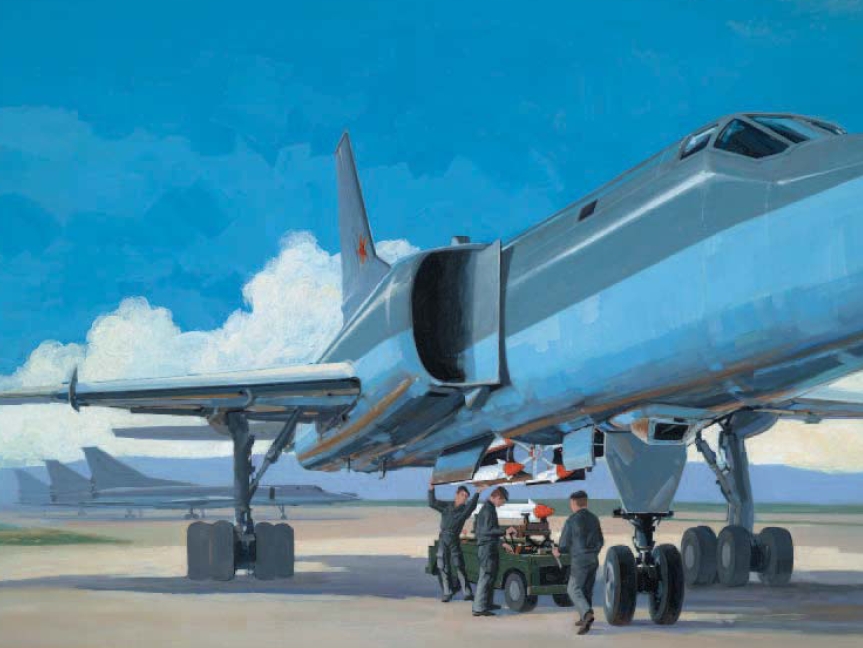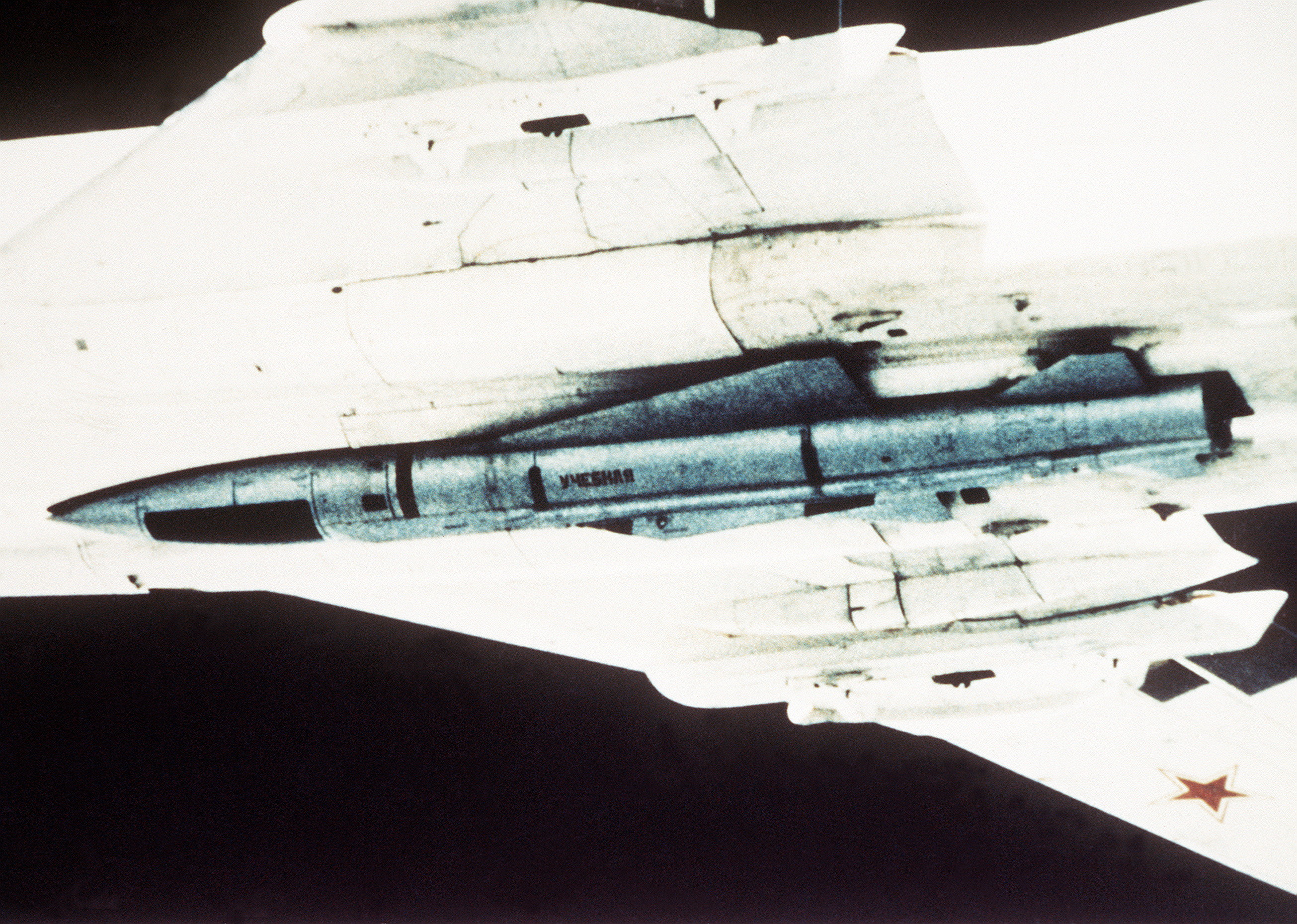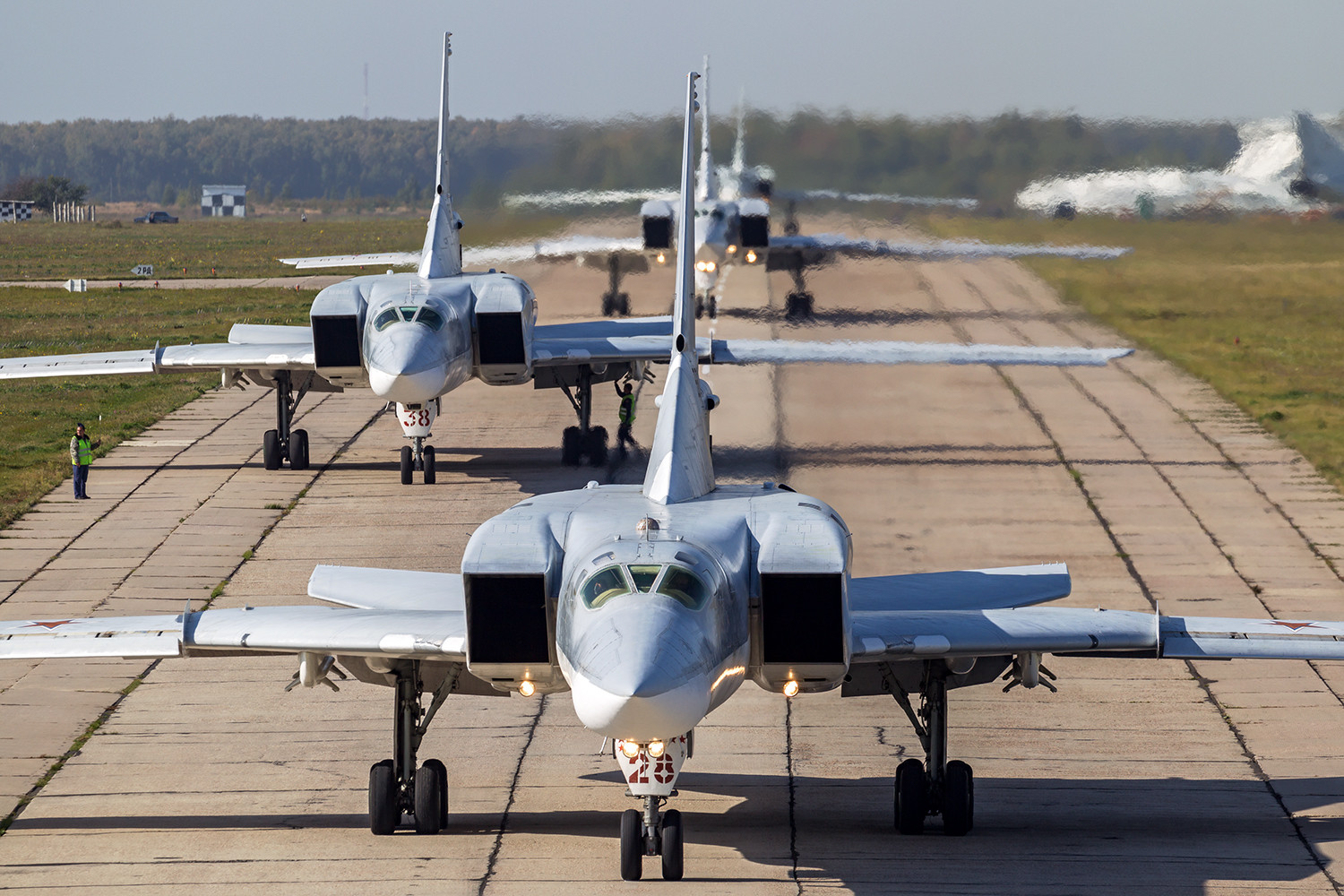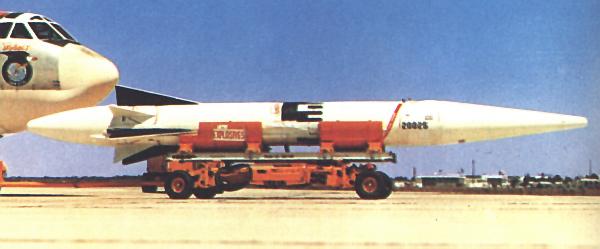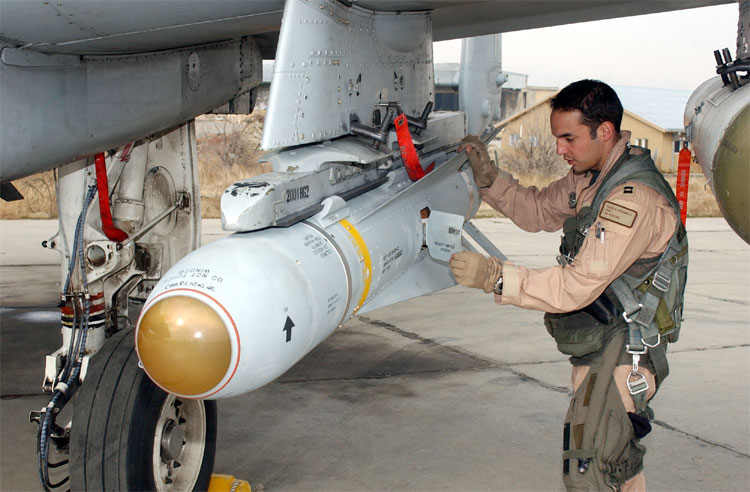|
Kh-15
The Raduga Kh-15 or RKV-15 (; NATO: AS-16 "Kickback") is a Soviet hypersonic aero-ballistic air-to-ground missile carried by the Tupolev Tu-22M and other bombers. Originally developed as a standoff nuclear air-to-ground missile similar to the U.S. Air Force's AGM-69 SRAM, versions with conventional warheads have been developed. As of early 2019, it was uncertain whether the Kh-15 was in service, with rumors that it had been retired or placed in storage. Development In 1967, MKB Raduga started developing the Kh-2000 as a replacement for the Kh-22 (NATO reporting name AS-4 Kitchen) heavy anti-shipping missile. Development of the Kh-15 started some time in the early 1970s. The sophistication of the design made it suitable for other roles, and a nuclear-tipped version was developed in tandem with the conventionally armed variant. An upgrade under development was cancelled in 1991, but reports in 1998 suggested an upgraded Kh-15 might be fitted to Su-35 (Flanker-E) tactical aircraft. ... [...More Info...] [...Related Items...] OR: [Wikipedia] [Google] [Baidu] |
Tupolev Tu-22M
The Tupolev Tu-22M (; NATO reporting name: Backfire) is a supersonic, variable-sweep wing, long-range strategic and maritime strike bomber developed by the Tupolev, Tupolev Design Bureau in the 1960s. The bomber was reported as being designated Tu-26 by Western intelligence at one time. During the Cold War, the Tu-22M was operated by the Soviet Air Forces (VVS) in a missile carrier strategic bombing role, and by the Soviet Naval Aviation (''Aviatsiya Voyenno-Morskogo Flota'', AVMF) in a long-range maritime anti-shipping role. In 2024, the Russian Air Force had 57 aircraft in service, according to the 2024 Military Balance report by International Institute for Strategic Studies. However, in 2023, Ukraine's Main Directorate of Intelligence (Ukraine), Main Directorate of Intelligence estimated that Russia had only 27 aircraft in operable condition. Development In 1962, after the introduction of the Tupolev Tu-22, it became increasingly clear that the aircraft was inadequate in i ... [...More Info...] [...Related Items...] OR: [Wikipedia] [Google] [Baidu] |
Tu-22M3
The Tupolev Tu-22M (; NATO reporting name: Backfire) is a supersonic, variable-sweep wing, long-range strategic and maritime strike bomber developed by the Tupolev Design Bureau in the 1960s. The bomber was reported as being designated Tu-26 by Western intelligence at one time. During the Cold War, the Tu-22M was operated by the Soviet Air Forces (VVS) in a missile carrier strategic bombing role, and by the Soviet Naval Aviation (''Aviatsiya Voyenno-Morskogo Flota'', AVMF) in a long-range maritime anti-shipping role. In 2024, the Russian Air Force had 57 aircraft in service, according to the 2024 Military Balance report by International Institute for Strategic Studies. However, in 2023, Ukraine's Main Directorate of Intelligence estimated that Russia had only 27 aircraft in operable condition. Development In 1962, after the introduction of the Tupolev Tu-22, it became increasingly clear that the aircraft was inadequate in its role as a bomber. In addition to widespread unser ... [...More Info...] [...Related Items...] OR: [Wikipedia] [Google] [Baidu] |
Tu-22M
The Tupolev Tu-22M (; NATO reporting name: Backfire) is a supersonic, variable-sweep wing, long-range strategic and maritime strike bomber developed by the Tupolev Design Bureau in the 1960s. The bomber was reported as being designated Tu-26 by Western intelligence at one time. During the Cold War, the Tu-22M was operated by the Soviet Air Forces (VVS) in a missile carrier strategic bombing role, and by the Soviet Naval Aviation (''Aviatsiya Voyenno-Morskogo Flota'', AVMF) in a long-range maritime anti-shipping role. In 2024, the Russian Air Force had 57 aircraft in service, according to the 2024 Military Balance report by International Institute for Strategic Studies. However, in 2023, Ukraine's Main Directorate of Intelligence estimated that Russia had only 27 aircraft in operable condition. Development In 1962, after the introduction of the Tupolev Tu-22, it became increasingly clear that the aircraft was inadequate in its role as a bomber. In addition to widespread unse ... [...More Info...] [...Related Items...] OR: [Wikipedia] [Google] [Baidu] |
Anti-ship Missile
An anti-ship missile (AShM or ASM) is a guided missile that is designed for use against ships and large boats. Most anti-ship missiles are of the sea-skimming variety, and many use a combination of inertial guidance and active radar homing. A large number of other anti-ship missiles use infrared homing to follow the heat that is emitted by a ship; it is also possible for anti-ship missiles to be guided by radio command all the way. Many anti-ship missiles can be launched from a variety of weapons systems including surface warships (also referred to as ship-to-ship missiles), submarines, bombers, fighter planes, patrol planes, helicopters, shore batteries, land vehicles, and, conceivably, even infantrymen firing shoulder-launched missiles. The term surface-to-surface missile (SSM) is used when appropriate. The longer-range anti-ship missiles are often called anti-ship cruise missiles. Several countries are also developing anti-ship ballistic missiles. Etymology Both ... [...More Info...] [...Related Items...] OR: [Wikipedia] [Google] [Baidu] |
MKB Raduga
MKB Raduga (, meaning Raduga Design Bureau (), where ''raduga'' literally means "rainbow") is a Russian aerospace company, concerned with the production of various missile-systems and related technologies. It is headquartered in Dubna, Moscow Oblast. Formerly a division of the Mikoyan-Gurevich design bureau, it was spun off as a separate OKB (design bureau, ) in March 1957. History * October 1946 - OKB-2 * 12 October 1951 - division of OKB-155-1 (headed by Mikhail Gurevich) * March 1957 - Aleksandr Bereznyak became the chief designer * June 1965 - machine building design bureau "Raduga" * 19 June 1972 - Dubna production and development amalgamation "Raduga" * 7 September 1978 - Dubna production amalgamation "Raduga" * 12 May 1982 - machine building design bureau "Raduga" Products Kometa series * KS-1 Komet (AS-1 "Kennel") - the first Soviet air-launched anti-ship cruise missile, began development 1947 * K-10S (AS-2 "Kipper") - heavy anti-ship missile, Tu-16, 1955 Nava ... [...More Info...] [...Related Items...] OR: [Wikipedia] [Google] [Baidu] |
Active Radar Homing
Active radar homing (ARH) is a missile guidance method in which a missile contains a radar transceiver (in contrast to semi-active radar homing, which uses only a passive radar, receiver) and the electronics necessary for it to find and track its target autonomously. The NATO brevity code for an air-to-air active radar homing missile launch is fox (code word), Fox Three. Advantages There are two major advantages to active radar homing: * As the missile is tracking the target it is going to be much closer to the target than the launching platform during the terminal phase, thus the missile's tracking can be much more accurate and better resistant to electronic countermeasures. Active radar homing missiles have some of the best kill probability, kill probabilities, along with missiles employing track-via-missile guidance. * Because the missile is totally autonomous during the terminal phase, the launch platform does not need to have its radar enabled at all during this phase, an ... [...More Info...] [...Related Items...] OR: [Wikipedia] [Google] [Baidu] |
Standoff Missile
Standoff weapons (or stand-off weapons) are missiles or bombs which may be launched from a distance sufficient to allow attacking personnel to evade the effect of the weapon or defensive fire from the target area. Typically, they are used against land- and sea-based targets in an offensive operation. The name is derived from their ability to engage the target while standing off outside the range at which the defenders are likely to engage the attacker. Typical stand-off weapons include cruise missiles, glide bombs and short-range ballistic missiles. Standoff missiles belong to the larger class of ranged weapons and are complemented by the Stand-in Attack Weapon (SiAW), a missile with a shorter range that is fired by an aircraft after penetrating enemy airspace. List of weapons * Air-Sol Moyenne Portée (ASMP) (French air-launched nuclear missile) * AGM-28 Hound Dog * AGM-69 SRAM (Short-Range Attack Missile) * AGM-84H/K SLAM-ER (Standoff Land Attack Missile-Expanded Response ... [...More Info...] [...Related Items...] OR: [Wikipedia] [Google] [Baidu] |
Air-launched Ballistic Missile
An air-launched ballistic missile (ALBM) is a ballistic missile launched from an aircraft. An ALBM allows the launch aircraft to stand off at long distances from its target, keeping it well outside the range of defensive weapons like anti-aircraft missiles and interceptor aircraft. Historically, once launched the missile was essentially immune to interception due to a lack of capable anti-ballistic missiles, with those few that did exist being limited to known static positions. This combination of features allowed a strategic bomber to present a credible deterrent second-strike option in an era when improving anti-aircraft defences appeared to be rendering conventional bombers obsolete. However, by the 1990s surface-to-air missile technology had innovated to the point of allowing the interception of such weapons (especially in their terminal phase) from road mobile systems, albeit at a lower probability of kill(PoK). By the early 21st century capable, dedicated, ABM systems ... [...More Info...] [...Related Items...] OR: [Wikipedia] [Google] [Baidu] |
Air-to-ground Missile
An air-to-surface missile (ASM) or air-to-ground missile (AGM) is a missile designed to be launched from military aircraft at targets on land or sea. There are also unpowered guided glide bombs not considered missiles. The two most common propulsion systems for air-to-surface missiles are rocket motors, usually with shorter range, and slower, longer-range jet engines. Some Soviet-designed air-to-surface missiles are powered by ramjets, giving them both long range and high speed. Guidance for air-to-surface missiles is typically via laser guidance, infrared guidance, optical guidance or via satellite guidance signals. The type of guidance depends on the type of target. Ships, for example, may be detected via passive radar or active radar homing, which is less effective against multiple, small, fast-moving land targets. There is some cross-over between air-to-surface missiles and surface-to-surface missiles. For example, there was an air-launched version of the Tomahawk mi ... [...More Info...] [...Related Items...] OR: [Wikipedia] [Google] [Baidu] |
Tu-160
The Tupolev Tu-160 (; NATO reporting name: Blackjack) is a supersonic, variable-sweep wing nuclear-capable heavy strategic bomber and airborne missile platform designed by the Tupolev Design Bureau in the Soviet Union in the 1970s. The aircraft is large, rather longer than a Boeing B-52 Stratofortress at 54 m, with wingspan 56 m when spread, 36 m when swept back. The Tu-160 is operated by the Long Range Aviation branch of the Russian Aerospace Forces. The Tu-160 entered service in 1987, the last strategic bomber designed for the Soviet Air Forces. It was built to serve as both a conventional and nuclear bomber. Production was stopped in 1992 following the dissolution of the Soviet Union in 1991, and the newly independent Russian and Ukrainian air forces inherited a fleet of 13 and 19 Tu-160s, respectively. Following protracted negotiations, eight Ukrainian Tu-160s were purchased by the Russian Federation while the remaining 11 were scrapped in the late 1990s u ... [...More Info...] [...Related Items...] OR: [Wikipedia] [Google] [Baidu] |
